iOS Programming - Views(视图 - 基本绘制,变换,平移,旋转,反转,倾斜)
1. Views
A view (an object whose class is UIView or a subclass of UIView) knows how to draw itself into a rectangular area of the interface.
Your app has a visible interface thanks to views.
(eg: you can drag an interface widget, such as a UIButton, into a view in the nib editor;
when the app runs, the button appears, and works properly.
You can also manipulate views in powerful ways, in real time. Your code can do some or all of the
view’s drawing of itself)
A view is also a responder (UIView is a subclass of UIResponder).
This means that a view is subject to user interactions, such as taps and swipes.
A view can have subviews;
If a view is removed from the interface, its subviews are removed;
if a view is hidden (made invisible), its subviews are hidden;
if a view is moved, its subviews move with it; and other changes in a view are likewise
shared with its subviews.
A view may come from a nib, or you can create it in code.
On balance, neither approach is to be preferred over the other; it depends on your needs and inclinations and on the
overall architecture of your app.
2. The Window
The top of the view hierarchy is the app’s window.
It is an instance of UIWindow (or your own subclass), which is a UIView subclass.
Your app should have exactly one main window. It is created at launch time and is never destroyed or replaced.
It occupies the entire screen and forms the background, and is the ultimate superview of, all your other visible views.
The window must fill the device’s screen.
This is done by setting the window’s frame to the screen’s bounds as the window is instantiated.
Objective-C:
UIWindow* w = [[UIWindow alloc] initWithFrame:[[UIScreen mainScreen] bounds]];
Swift(iOS8):
let w = UIWindow(frame: UIScreen.mainScreen().bounds)
Swift(iOS9):
// it’s sufficient to instantiate UIWindow with no frame
let w = UIWindow()
You will typically not put any view content manually and directly inside your main window.
Instead, you’ll obtain a view controller and assign it to the main window’s root ViewController property.
This causes the view controller’s main view (its view) to be made the one and only immediate subview of
your main window, which is the main window’s root view.
All other views in your main window will be subviews of the root view. Thus,
the root view is the highest object in the view hierarchy that the user will usually see.
Your app’s interface is not visible until the window, which contains it, is made the app’s
key window. This is done by calling the UIWindow instance method makeKeyAndVisible.
When addSubview: is called, the view is placed last among its superview’s subviews;
thus it is drawn last, meaning that it appears frontmost.
(最后绘制的,出现在最前面)
// it is legal to cycle through it and remove each subview one at a time
for (UIView* v in view.subviews)
[v removeFromSuperview];
3. Visibility and Opacity(可见性与不透明度)
A view can be made invisible by setting its hidden property to YES, and visible again
by setting it to NO.
A view can be assigned a background color through its backgroundColor property. A
color is a UIColor;
A view whose background color is nil (the default) has a transparent background.
A view can be made partially or completely transparent through its alpha property: 1.0
means opaque, 0.0 means transparent, and a value may be anywhere between them,
inclusive.
This affects subviews: if a superview has an alpha of 0.5, none of its subviews
can have an apparent opacity of more than 0.5, because whatever alpha value they have
will be drawn relative to 0.5.
A view that is completely transparent (or very close to it) is like a view whose hidden is
YES: it is invisible, along with its subviews, and cannot (normally) be touched.
eg:
if a view displays an image and has a background color and its alpha is less than 1, the background color
will seep through the image (背景色将渗入图像).
4. Frame
A view’s frame property, a CGRect, is the position of its rectangle within its superview.
By default, the superview’s coordinate system will have the origin at its top left,
with the x-coordinate growing positively rightward and the y-coordinate growing positively downward.
(等同于Cocos2d-x中的UI坐标系,原点在左上角)
Setting a view’s frame to a different CGRect value repositions the view, or resizes it, or both.
例: 画3个部分重叠的视图
Objective-C:
UIView* v1 = [[UIView alloc] initWithFrame:CGRectMake(, , , )];
v1.backgroundColor = [UIColor colorWithRed: green:. blue: alpha:];
UIView* v2 = [[UIView alloc] initWithFrame:CGRectMake(, , , )];
v2.backgroundColor = [UIColor colorWithRed:. green: blue: alpha:];
UIView* v3 = [[UIView alloc] initWithFrame:CGRectMake(, , , )];
v3.backgroundColor = [UIColor colorWithRed: green: blue: alpha:];
[mainview addSubview: v1];
[v1 addSubview: v2];
[mainview addSubview: v3];
Swift:
let v1 = UIView(frame:CGRectMake(, , , ))
v1.backgroundColor = UIColor(red: , green: 0.4, blue: , alpha: )
let v2 = UIView(frame:CGRectMake(, , , ))
v2.backgroundColor = UIColor(red: 0.5, green: , blue: , alpha: )
let v3 = UIView(frame:CGRectMake(, , , ))
v3.backgroundColor = UIColor(red: , green: , blue: , alpha: )
mainview.addSubview(v1)
v1.addSubview(v2)
mainview.addSubview(v3)
效果:
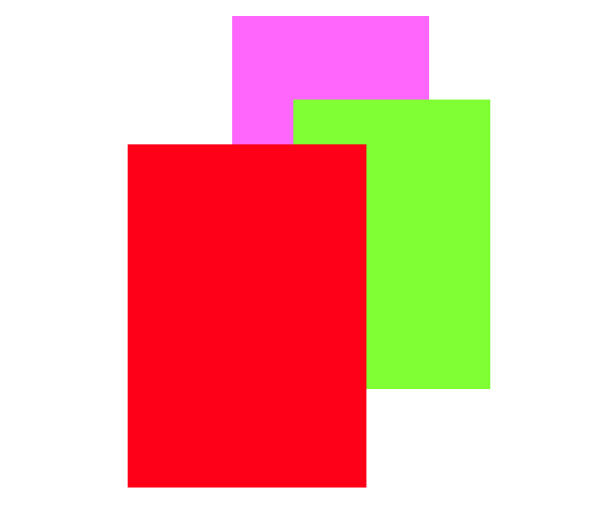
5. Bounds and Center(边框和中心)
CGRectInset函数,画出视图边框
例1: 画一个带有粗边框的视图
UIView* v1 = [[UIView alloc] initWithFrame:CGRectMake(, , , )];
v1.backgroundColor = [UIColor colorWithRed: green:. blue: alpha:];
UIView* v2 = [[UIView alloc] initWithFrame:CGRectInset(v1.bounds, , )];
v2.backgroundColor = [UIColor colorWithRed:. green: blue: alpha:];
[mainview addSubview: v1];
[v1 addSubview: v2];
效果:
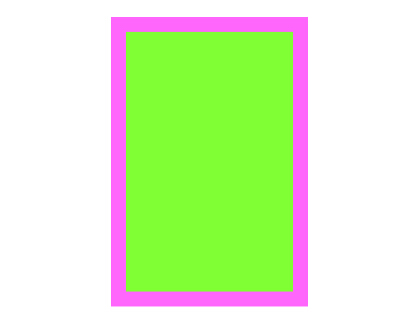
例2: 移动超视图(spuerview)的原点导致子视图(subview)位置发生变化
(本例中子视图向左上移动)
UIView* v1 = [[UIView alloc] initWithFrame:CGRectMake(, , , )];
v1.backgroundColor = [UIColor colorWithRed: green:. blue: alpha:];
UIView* v2 = [[UIView alloc] initWithFrame:CGRectInset(v1.bounds, , )];
v2.backgroundColor = [UIColor colorWithRed:. green: blue: alpha:];
[mainview addSubview: v1]
[v1 addSubview: v2];
CGRect r = v1.bounds;
r.origin.x += ;
r.origin.y += ;
v1.bounds = r;
效果:
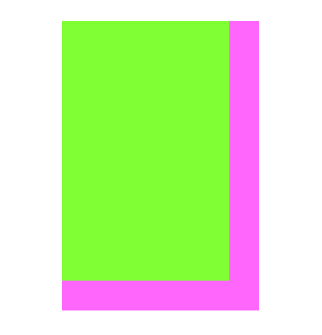
6. Transform(变换)
旋转(rotation), 缩放(scaling), 平移(translation)
例1: 视图顺时针旋转45度角
UIView* v1 = [[UIView alloc] initWithFrame:CGRectMake(, , , )];
v1.backgroundColor = [UIColor colorWithRed: green:. blue: alpha:];
UIView* v2 = [[UIView alloc] initWithFrame:CGRectInset(v1.bounds, , )];
v2.backgroundColor = [UIColor colorWithRed:. green: blue: alpha:];
[mainview addSubview: v1];
[v1 addSubview: v2];
v1.transform = CGAffineTransformMakeRotation( * M_PI/180.0);
效果: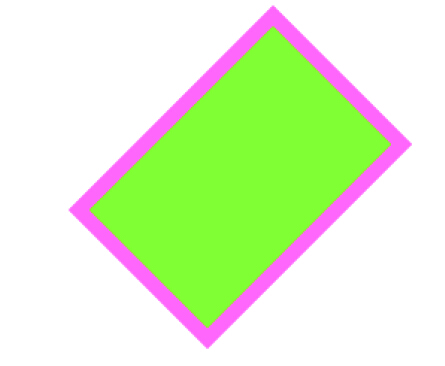
例2: 缩放变换
v1.transform = CGAffineTransformMakeScale(1.8, );
效果: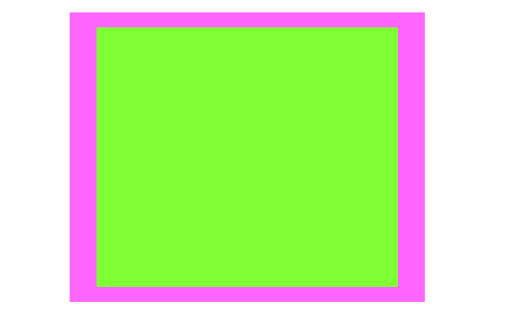
例3: 子视图先平移后旋转
UIView* v1 = [[UIView alloc] initWithFrame:CGRectMake(, , , )];
v1.backgroundColor = [UIColor colorWithRed: green:. blue: alpha:];
UIView* v2 = [[UIView alloc] initWithFrame:v1.bounds];
v2.backgroundColor = [UIColor colorWithRed:. green: blue: alpha:];
[mainview addSubview: v1];
[v1 addSubview: v2];
v2.transform = CGAffineTransformMakeTranslation(, );
v2.transform = CGAffineTransformRotate(v2.transform, * M_PI/180.0);
效果: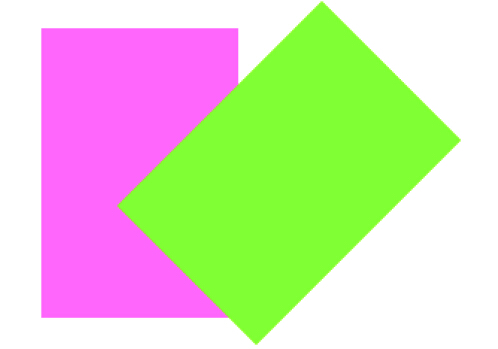
例4: 子视图先旋转后平移
v2.transform = CGAffineTransformMakeRotation( * M_PI/180.0);
v2.transform = CGAffineTransformTranslate(v2.transform, , );
效果:
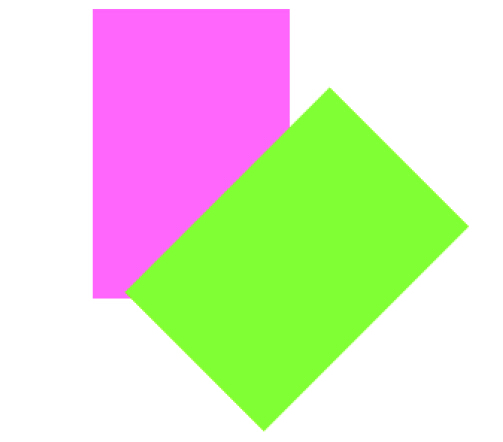
例5: 旋转平移后再反转(删除旋转)
CGAffineTransformConcat - 合并两个变换动作
CGAffineTransform r = CGAffineTransformMakeRotation( * M_PI/180.0);
CGAffineTransform t = CGAffineTransformMakeTranslation(, );
v2.transform = CGAffineTransformConcat(t,r);
v2.transform =
CGAffineTransformConcat(CGAffineTransformInvert(r), v2.transform);
效果: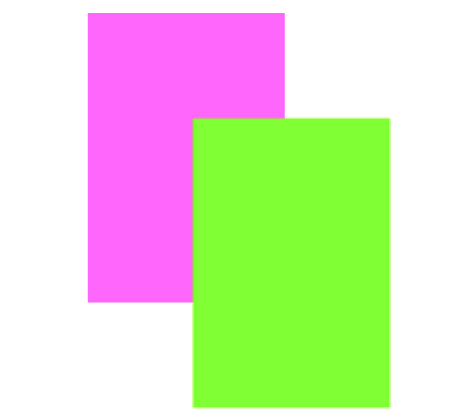
例6: 倾斜
v1.transform = CGAffineTransformMake(, , -0.2, , , );
效果: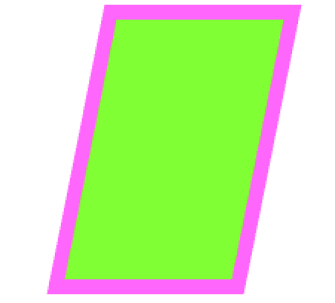
iOS Programming - Views(视图 - 基本绘制,变换,平移,旋转,反转,倾斜)的更多相关文章
- iOS Programming Views :Redrawing and UIScrollView
iOS Programming Views :Redrawing and UIScrollView 1.1 event You are going to see how views are red ...
- iOS Programming View and View Hierarchy 视图和视图等级
iOS Programming View and View Hierarchy 视图和视图等级 1.1(1)File → New → Project.. From the iOS section, ...
- Collection View Programming Guide for iOS---(一)----About iOS Collection Views
Next About iOS Collection Views 关于iOS Collection Views A collection view is a way to present an orde ...
- iOS Programming View Controllers 视图控制器
iOS Programming View Controllers 视图控制器 1.1 A view controller is an instance of a subclass of UIVi ...
- [ios学习笔记之视图、绘制和手势识别]
一 视图 二 绘制 三 手势 00:31 UIGestureRecognizer 抽象类 两步 1添加识别器(控制器或者视图来完成) 2手势识别后要做的事情 UIPanGestureRecognize ...
- Scene视图辅助线绘制
有时候需要在Scene视图中绘制一些辅助线,方便进行一些编辑的工作,可以通过如下类和函数完成: 绘制辅助线,相关类: Gizmos类:用于在Scene视图中绘制调试信息或辅助线,这些辅助线只有在Sce ...
- iOS核心动画高级技巧之图层变换和专用图层(二)
iOS核心动画高级技巧之CALayer(一) iOS核心动画高级技巧之图层变换和专用图层(二)iOS核心动画高级技巧之核心动画(三)iOS核心动画高级技巧之性能(四)iOS核心动画高级技巧之动画总结( ...
- iOS Programming State Restoration 状态存储
iOS Programming State Restoration 状态存储 If iOS ever needs more memory and your application is in the ...
- iOS Programming Introduction to Auto Layout 自动布局
iOS Programming Introduction to Auto Layout 自动布局 A single application that runs natively on both t ...
随机推荐
- SocketCluster
官网地址:https://socketcluster.io/ SocketCluster的组成部分,即运行一个SocketCluster服务器,它在服务器生成的进程 1.主进程(Server.js)一 ...
- ajax向php传参数对数据库操作
刚入门php,要求要对多用户进行批量删除(当然实际中是不可能的),在这就以此为例. 大意就是通过对数据库中用户查询,将用户信息显示在页面表格中,在进行多项选择后将所选行参数通过ajax传入后台php文 ...
- 笔试之random7生成random10
/*头条 已知有个Random7()的函数,返回1到7随机自然数,让利用这个Random7()构造Random10()随机1~10. random7构造1~49,限制到1~40,对10求余再+1 */ ...
- CodeForces 143C Help Farmer
暴力枚举. 枚举最小的那个数字,不会超过$1000$,剩下的两个数字根号的效率枚举一下即可. #include<bits/stdc++.h> using namespace std; lo ...
- CodeForces 734E Anton and Tree
$dfs$缩点,树形$dp$. 首先将连通块缩点,缩点后形成一个黑白节点相间的树.接下来的任务就是寻找一个$root$,使这棵树以$root$为根,树的高度是最小的(也就是一层一层染色).树形$dp$ ...
- “玲珑杯”ACM比赛 Round #19 B -- Buildings (RMQ + 二分)
“玲珑杯”ACM比赛 Round #19 Start Time:2017-07-29 14:00:00 End Time:2017-07-29 16:30:00 Refresh Time:2017-0 ...
- 【2-sat】Gym - 101201F - Illumination
题意:平面上l盏灯,每盏灯可以照亮横向的2*r+1个格子或者纵向的2*r+1个格子,让你确定每盏灯的方向,使得每个格子只被同一行的不超过一盏灯照亮,并且只被同一列的不超过一盏灯照亮.输出是否有解. 显 ...
- xml和集合混合使用-图书管理器
package com.book; public class Book { private int id; //图书编号 private String name; //图书名称 private Str ...
- 通过现有数据导出新表SQL
Date: 20140217 Auth: JIN 需求: 导出一个表的两个列的表的SQL语句(包含数据) 方法:创立一个临时表 mysql> desc kw_keywords;+-------- ...
- WebService基于SoapHeader实现安全认证(二)
支持通过Http请求方法调用webservice,同时支持SoapHeader验证. using Globalegrow.Common; using Globalegrow.Model; using ...
